Appliances
What Do the Buttons on the Ceiling Fan Remote Mean?
2025
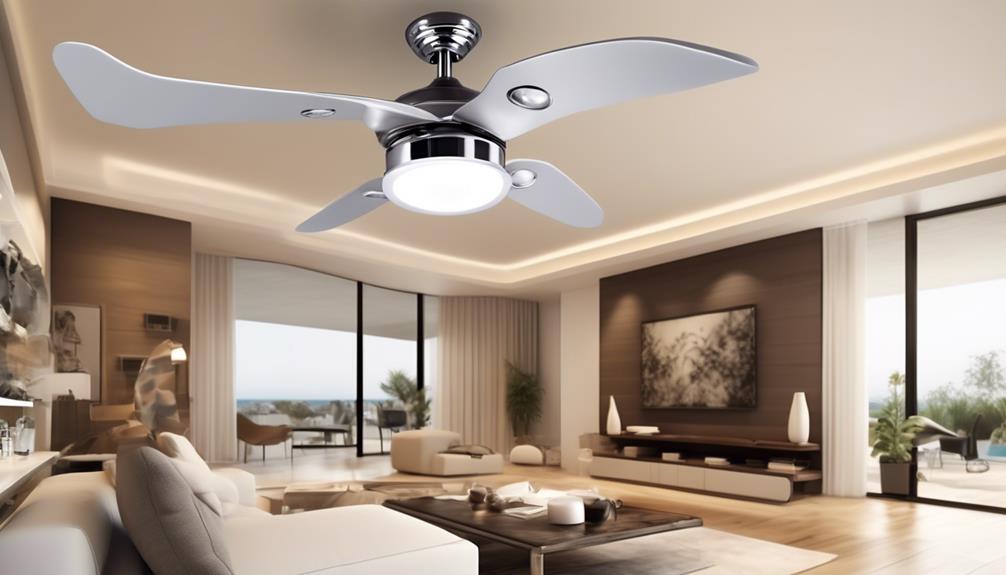
Have you ever been in a situation where you’re in a room, feeling slightly overheated, and longing for some magical tool to help cool you off?
Well, fear not, my friends, for we have the answer! Today, we will unravel the mysteries of the buttons on the ceiling fan remote.
This nifty little gadget has the power to bring comfort to your life with just a push of a button. In this guide, we will explore the various functions of the remote, from the power button that brings the fan to life, to the speed control buttons that determine the airflow, and even the light control button that illuminates your surroundings.
So sit back, relax, and let us enlighten you on the wonders of the ceiling fan remote.
Key Takeaways
- The power button on the ceiling fan remote controls the fan's power and is essential for turning the fan on or off.
- The speed control buttons adjust the fan's rotation speed, with most remotes offering three speed settings: low, medium, and high.
- The light control button manages the ceiling fan's lighting, allowing users to turn the lights on and off and adjust brightness levels.
- The directional button controls the rotation direction of the fan blades, optimizing airflow for different seasons. Additionally, the timer button enables the fan's automatic shut-off feature, conserving energy by allowing users to set a specific time for the fan to turn off.
Power Button
The power button on a ceiling fan remote allows us to easily control the fan's power with a simple press. This button is crucial in turning the fan on or off, making it an essential component of the remote. By pressing the power button, we can activate the fan and adjust its power settings according to our needs.
Troubleshooting issues with the power button can sometimes arise, but they can be resolved in a few simple steps. If the power button isn't working, the first thing to check is the batteries in the remote. Ensure that they're properly inserted and have enough charge. If the batteries are fine, try resetting the remote by removing the batteries and holding down the power button for a few seconds.
Once the remote is reset, reinsert the batteries and test the power button again. If the issue persists, it may be necessary to replace the remote or contact customer support for further assistance.
Speed Control Buttons
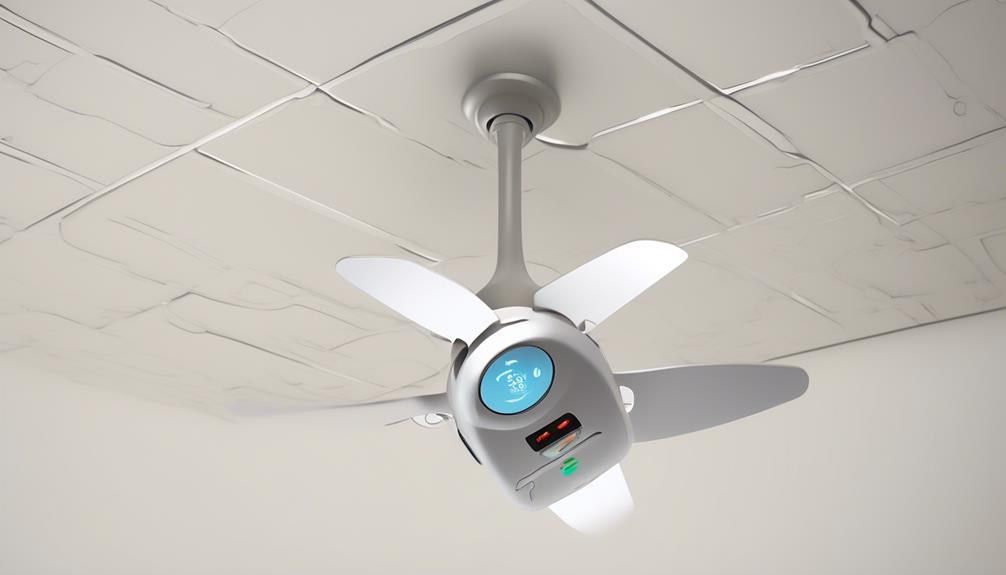
After ensuring the power button is functioning properly, we can now move on to discussing the speed control buttons on a ceiling fan remote. These buttons allow you to adjust the speed at which the fan blades rotate, giving you control over the airflow in the room. Most ceiling fan remotes come with three speed settings: low, medium, and high.
Controlling the speed of your ceiling fan can have a significant impact on the noise level in the room. Generally, the higher the speed, the louder the noise. If you prefer a quiet environment, you can set the fan to a low speed. However, keep in mind that a slower speed may also result in less airflow.
When it comes to energy efficiency, it's essential to consider the speed at which your ceiling fan operates. Running the fan on a higher speed will consume more energy compared to running it on a lower speed. If you're looking to save energy and reduce your electricity bill, it's recommended to use the lowest speed setting that still provides you with the desired airflow.
Light Control Button
To control the lighting of your ceiling fan, you can utilize the light control button on the remote. This button allows you to turn the lights on and off and also provides additional functionality such as dimming the lights.
Here are four important things to know about the light control button:
- Dimming Feature: The light control button on your ceiling fan remote may have a dimming feature. This allows you to adjust the brightness of the lights according to your preference. Simply press and hold the button to dim the lights or brighten them.
- On/Off Functionality: One of the primary functions of the light control button is to turn the lights on and off. Pressing the button once will toggle the lights between these two states.
- Troubleshooting Tips: If your ceiling fan lights aren't responding to the light control button, there are a few troubleshooting steps you can try. First, check if the light bulbs are properly screwed in and functioning. If they are, ensure that the remote has fresh batteries. If the issue persists, consult the user manual or contact customer support for further assistance.
- Additional Features: Some ceiling fan remotes offer additional features related to the light control button, such as setting timers for the lights to automatically turn on or off at specific times. Check your remote's user manual to explore these advanced functionalities.
With the light control button on your ceiling fan remote, you can easily adjust the lighting in your room and create the desired ambiance.
Directional Button
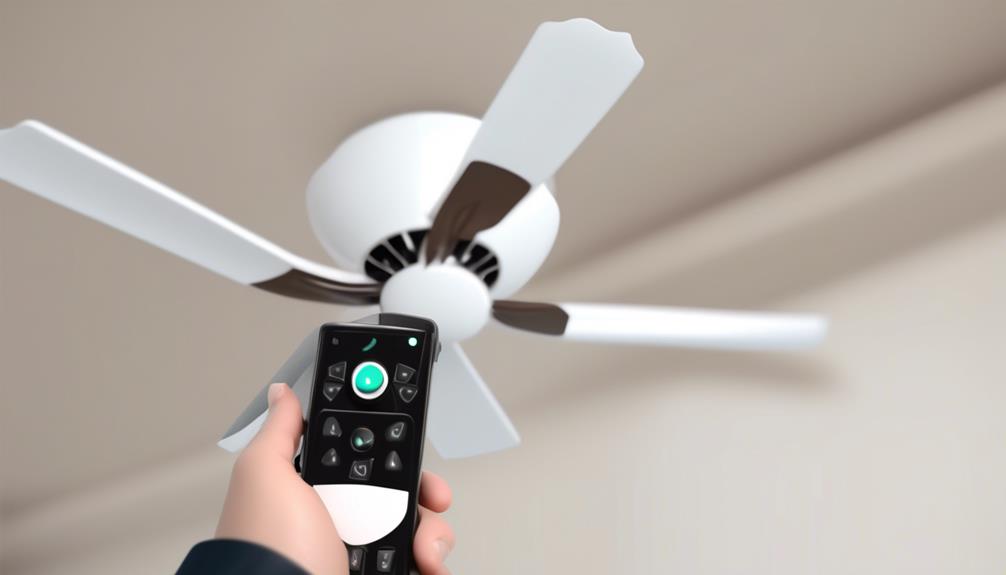
The directional button on your ceiling fan remote allows you to control the direction in which the fan blades rotate. This feature is essential for optimizing the airflow in your room and creating a comfortable environment. By pressing the directional button, you can switch between clockwise rotation and counterclockwise rotation.
Clockwise rotation is typically used during colder months. When the fan blades rotate in a clockwise direction, they create an updraft that pushes warm air near the ceiling down into the room. This can help distribute heat more evenly and reduce the need for using additional heating sources.
On the other hand, counterclockwise rotation is ideal for warmer months. When the fan blades rotate counterclockwise, they create a downdraft that produces a cooling effect by moving air downwards. This can make you feel more comfortable by promoting evaporation of perspiration on your skin, creating a wind chill effect.
Timer Button
Now let's explore the functionality of the timer button on your ceiling fan remote, allowing you to conveniently set a specific duration for the fan to operate. Understanding the timer button functions is essential for using it effectively and conserving energy.
Here are four key aspects to consider:
- Delay start: The timer button lets you delay the start of the fan for a certain period. This can be useful if you want the fan to turn on after you've fallen asleep or if you want to come home to a cool room.
- Duration settings: You can set the fan to operate for a specific duration, such as 30 minutes or 1 hour. This feature ensures that the fan doesn't run unnecessarily and helps conserve energy.
- Automatic shut-off: The timer button allows you to program the fan to automatically shut off after a certain time. This is particularly useful if you tend to forget to turn off the fan when leaving the room.
- Customizable options: Depending on the model of your ceiling fan remote, you may have additional customizable options with the timer button. These can include setting different durations for different times of the day or setting the fan to turn on and off at specific intervals.
Can Resetting the Ceiling Fan Remote Help me Understand Its Functions Better?
Yes, resetting your Hampton Bay ceiling fan can actually help you understand its functions better. By resetting the ceiling fan remote, you can troubleshoot any issues and familiarize yourself with its features. This simple step can improve the overall performance and operation of your ceiling fan.
Frequently Asked Questions
Can I Control Multiple Ceiling Fans With One Remote?
Controlling multiple ceiling fans with one remote has its advantages. It allows for easy management and convenience.
To sync multiple fans to one remote, follow these steps:
1) Turn off the power to all fans.
2) Locate the receiver in each fan and set the dip switches to the same pattern.
3) Turn the power back on.
4) Press and hold the sync button on the remote and wait for the fans to respond.
Once synced, you can control all fans with just one remote.
How Do I Change the Batteries in the Ceiling Fan Remote?
To change the batteries in the ceiling fan remote, first locate the battery compartment on the back of the remote.
Open the compartment and remove the old batteries.
Insert new batteries, ensuring they're properly aligned with the correct polarity.
Close the compartment and test the remote to ensure it's functioning properly.
If the remote still doesn't work, you may need to troubleshoot further or consult the manufacturer's instructions.
What Should I Do if the Remote Is Not Working?
If the remote isn't working, there are a few troubleshooting tips we can try.
First, check the batteries and make sure they're inserted correctly.
Next, ensure that the remote and the fan are properly paired.
If that doesn't work, try resetting the remote by removing the batteries and pressing all the buttons for a few seconds.
If these common remote issues persist, it may be time to contact customer support for further assistance.
Can I Adjust the Fan Speed Without Using the Remote?
We can adjust the fan speed without using the remote by using alternative fan controls. If the remote isn't working, troubleshooting fan speed adjustment can be done by checking the wall switch. Make sure it's turned on and functioning properly.
Additionally, some ceiling fans have pull chains that can be used to adjust the fan speed. Refer to the fan's manual for specific instructions on how to use these alternative controls.
Is It Possible to Program the Remote to Control Other Devices Besides the Ceiling Fan?
It is possible to program the remote to control other devices besides the ceiling fan. However, there are programming limitations and compatibility issues to consider.
Some ceiling fan remotes are designed to only work with specific devices, while others may have broader compatibility. It's important to carefully read the instruction manual or consult with the manufacturer to determine if the remote can be programmed for other devices.
Conclusion
In conclusion, understanding the buttons on your ceiling fan remote can greatly enhance your comfort and convenience.
While it may seem overwhelming at first, familiarizing yourself with the power, speed control, light control, directional, and timer buttons will enable you to create the perfect environment in your home.
Don't let the complexity discourage you; take the time to explore and experiment with the different functions to maximize your fan's potential.
Stay cool and enjoy the benefits of a well-utilized ceiling fan!
- About the Author
- Latest Posts
Introducing Ron, the home decor aficionado at ByRetreat, whose passion for creating beautiful and inviting spaces is at the heart of his work. With his deep knowledge of home decor and his innate sense of style, Ron brings a wealth of expertise and a keen eye for detail to the ByRetreat team.
Ron’s love for home decor goes beyond aesthetics; he understands that our surroundings play a significant role in our overall well-being and productivity. With this in mind, Ron is dedicated to transforming remote workspaces into havens of comfort, functionality, and beauty.
Garage Door Opener
Clearance Garage Door Opener Installation Guide
Navigate the complexities of installing a garage door opener with ample overhead clearance, uncovering the key steps for a seamless setup.
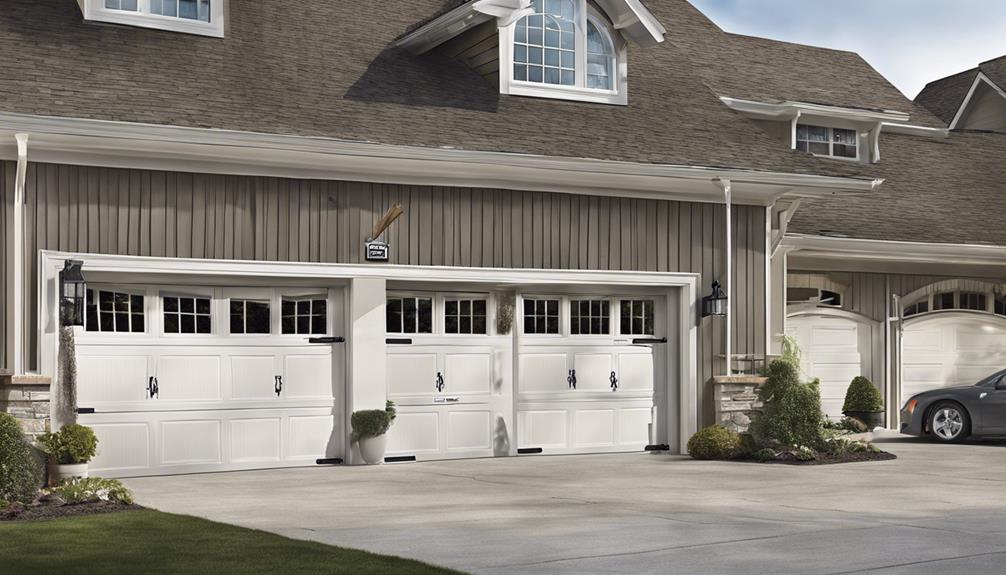
Have you ever thought about the details involved in installing a garage door opener with enough overhead clearance? How difficult is it to make sure the installation is smooth and guarantees the best performance? Well, don’t worry, as we will walk you through the necessary steps for getting your garage door opener set up.
From measuring overhead space to selecting the right opener and testing its functionality, our discussion will equip you with the necessary knowledge to tackle this task effectively. Let's unravel the secrets to a successful garage door opener installation together.
Key Takeaways
- Accurate measurement and ample clearance space are crucial for smooth installation.
- Choose a low-profile opener for limited headroom, featuring modern connectivity and quiet operation.
- Prepare a clutter-free workspace with proper lighting for efficient installation.
- Test functionality thoroughly, adjusting as needed for safe and optimal garage door operation.
Measure Overhead Clearance Space
To ensure proper installation of the garage door opener, it's crucial to accurately measure the overhead clearance space between the top of the garage door and the ceiling. The vertical space is essential for the garage door opener and its components to operate smoothly and without any hindrances.
When measuring the overhead clearance, take into account the drive garage door opener's specifications provided by the manufacturer. These specifications will outline the required vertical space needed for the specific model being installed. Additionally, consider any extra accessories or modifications that may impact the overhead clearance space, ensuring that there's ample room for safe and efficient operation.
Select Low-Profile Garage Door Opener
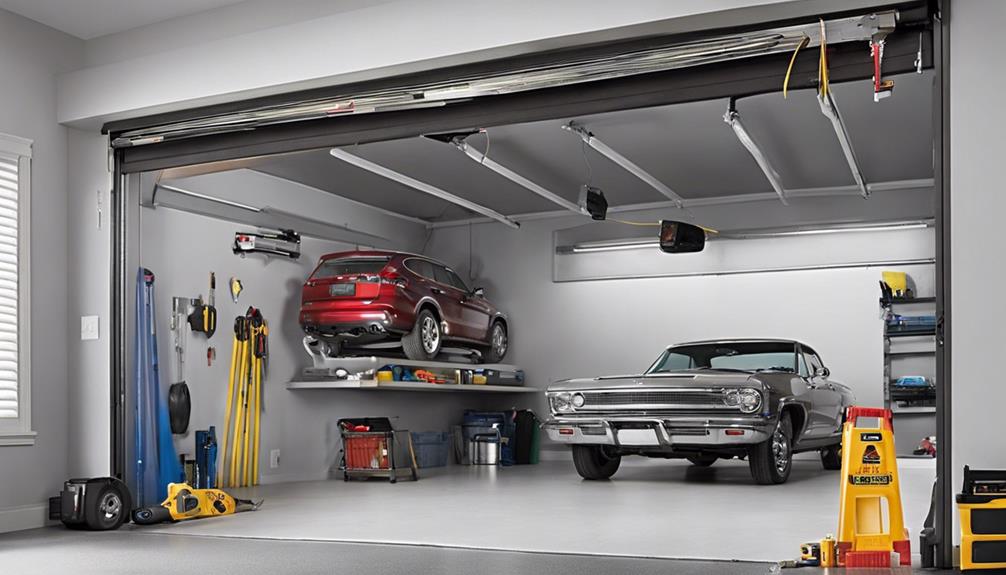
Having ensured the adequate overhead clearance space for the garage door opener installation, the next step is to carefully select a low-profile garage door opener that fits snugly in tight spaces while offering advanced features and compatibility with various door types.
Low-profile garage door openers are specifically designed to accommodate limited headroom situations, making them perfect for garages with space constraints. Their compact and sleek design allows for discreet installation without occupying much room. These openers often come equipped with modern conveniences like smartphone connectivity, battery backup, and quiet belt drive operation for a seamless user experience. Additionally, their compatibility with a range of garage door sizes and types provides installation flexibility.
Energy efficiency is another advantage, as low-profile garage door openers can help reduce electricity consumption, leading to potential long-term cost savings. When choosing a low-profile garage door opener, consider factors such as the size of your garage door and the desired features for optimal performance.
Prepare Workspace for Installation
Clearing the area around the garage door opener is essential to provide ample space for a smooth installation process. Before beginning the installation of the garage door opener, it's crucial to ensure that there are no obstructions or clutter that may hinder the process.
By creating a clean and organized workspace, you can work efficiently and safely. Remove any tools or items that may interfere with the installation of the garage door opener to streamline the process. Keeping the workspace well-lit and free from distractions will allow you to focus on the installation tasks at hand.
Install Opener According to Manual
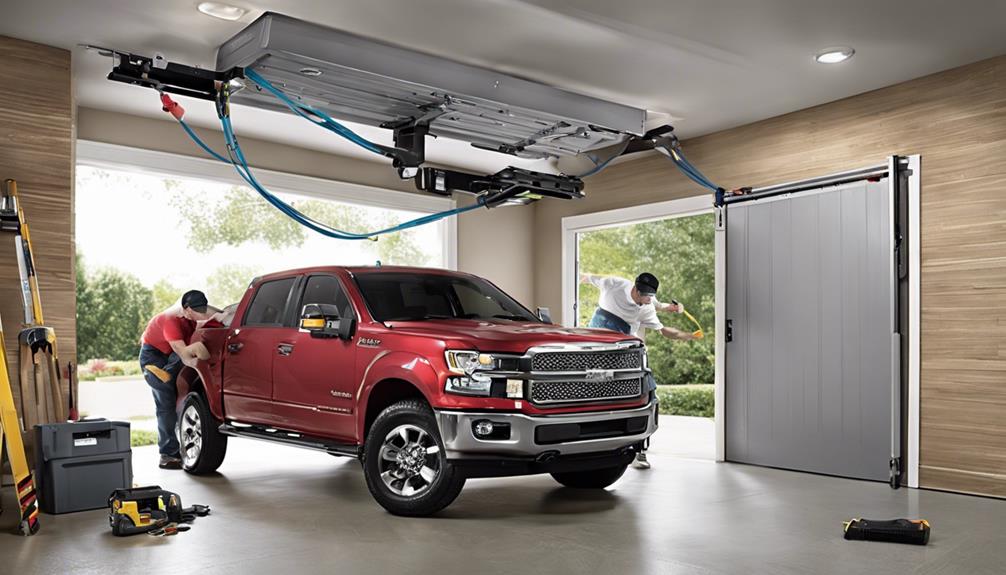
Following the manufacturer's manual meticulously is crucial for the precise installation of the garage door opener. To ensure a successful installation, our team recommends the following steps:
- Positioning Components: Properly position and secure all garage door opener components as instructed in the manual. This ensures the safe and efficient operation of the opener.
- Connecting Wiring: Connect all wiring and mechanisms according to the manual's specifications. Proper connection is vital to prevent malfunctions and ensure smooth functioning of the garage door.
- Adhering to Guidelines: Adhere strictly to the manual's guidelines for installing the opener. These guidelines are designed by professional garage door experts to guarantee a correct and secure installation.
Test Functionality and Adjust if Needed
To ensure the garage door opener functions smoothly and safely, thorough testing and potential adjustments are essential. Begin by testing the garage door's opening and closing functionality multiple times to guarantee a seamless operation.
Listen for any unusual sounds and watch out for jerky movements or obstructions that may impede the door's movement. If any issues arise, consider adjusting the opener's settings to enhance the door's operation and clearance within the garage space.
It's crucial to verify that the door clears the opening without any problems or interference. Additionally, confirm that the safety sensors are operational and don't hinder the door's movement in any way, ensuring a safe and efficient garage door operation.
Frequently Asked Questions
How Much Clearance Do You Need to Install a Garage Door Opener?
We need a minimum of 2 inches of clearance above the garage door for installing most openers. It's crucial to check the manufacturer's specifications for the exact clearance required by your specific opener model.
Taller doors or special opener features may demand more clearance. The needed space can vary depending on the opener type, like chain-drive, belt-drive, or screw-drive.
Adequate clearance ensures smooth opener operation and prevents door movement interference.
What Is the Minimum Clearance Above a Garage Door for an Opener?
We need at least 2 inches of clearance above a garage door for an opener to work effectively. Some models might require up to 3 inches, depending on their design. Too little space can lead to operational issues and potential damage.
It's crucial to measure accurately before installing to avoid problems. Always refer to the manufacturer's guidelines for the specific opener model to ensure the right clearance.
How Much Does Lowes Charge to Install a Garage Door Opener?
We love the convenience of Lowe's garage door opener installation services, starting at $127, with pricing varying based on installation complexity.
Extra charges may apply for services like removing old openers or installing new electrical outlets. Remember, the installation cost doesn't include the price of the garage door opener itself, which must be purchased separately.
Rest assured, Lowe's provides professional installation by licensed and insured contractors for peace of mind.
How Close Do You Have to Be for Garage Door Opener?
We need to be within 25-35 feet for the garage door opener to work.
Sensors should be placed 4-6 inches above the floor to detect obstacles.
Some models offer Wi-Fi connectivity, enabling remote access.
Advanced features like battery backup ensure operation during power outages.
These key factors influence how close we must be for the garage door opener to function effectively.
Conclusion
In conclusion, installing a low-profile garage door opener is like fitting a key into a lock – precise, smooth, and essential for seamless operation.
By following the detailed steps in the clearance garage door opener installation guide, you can ensure your opener functions flawlessly and efficiently.
Remember to test the functionality and make any necessary adjustments for optimal performance.
With proper installation and maintenance, your garage door opener will open up a world of convenience for you.
- About the Author
- Latest Posts
Introducing Ron, the home decor aficionado at ByRetreat, whose passion for creating beautiful and inviting spaces is at the heart of his work. With his deep knowledge of home decor and his innate sense of style, Ron brings a wealth of expertise and a keen eye for detail to the ByRetreat team.
Ron’s love for home decor goes beyond aesthetics; he understands that our surroundings play a significant role in our overall well-being and productivity. With this in mind, Ron is dedicated to transforming remote workspaces into havens of comfort, functionality, and beauty.
Garage Door Opener
What Makes the Glink Garage Door Opener Stand Out?
Outstanding safety features and user-friendly functionalities distinguish the Glink Garage Door Opener – but what else makes it a game-changer?
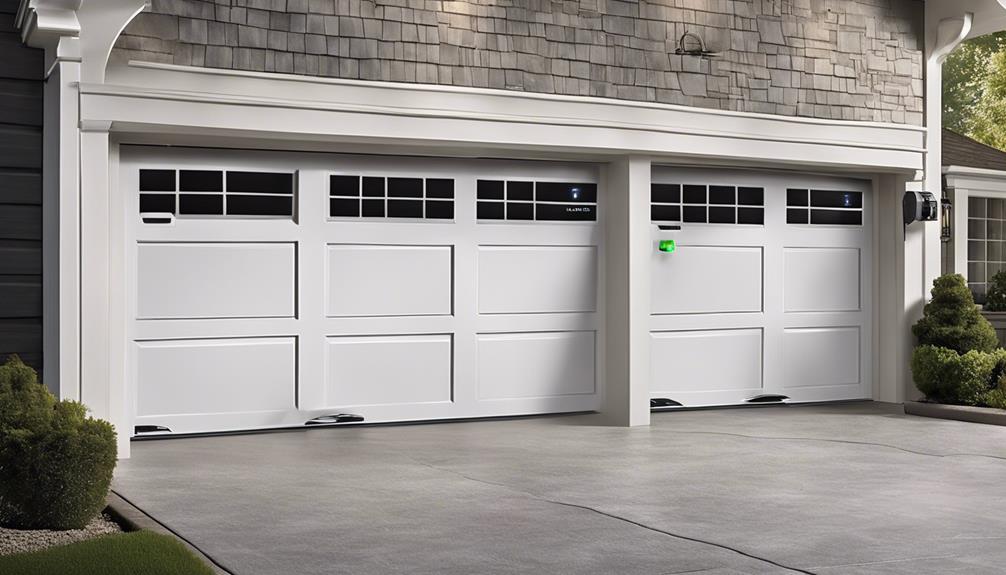
When it comes to garage door openers, the Glink Garage Door Opener really stands out. Its unparalleled level of innovation and attention to detail in features sets it apart in the market.
From cutting-edge safety measures to user-friendly functionalities, the Glink Garage Door Opener has redefined what we expect from this essential home device.
But what exactly makes it stand out from the rest? Let's explore further.
Key Takeaways
- Built-in camera for live monitoring adds security and convenience.
- Belt-driven openers ensure quiet performance for a peaceful environment.
- Advanced Wi-Fi connectivity allows for remote access and smart home integration.
- High-grade steel construction and advanced motor technology ensure durability and reliability.
Innovative Features of Glink Garage Door Opener
The Glink Garage Door Opener revolutionizes home security with its cutting-edge built-in camera for live monitoring capabilities, setting a new standard in garage door technology. When it comes to garage door maintenance, one crucial aspect is the proper lubrication of moving parts to ensure smooth operation. The Glink opener excels in this area by incorporating a sophisticated spring system that enhances the overall functionality and longevity of the garage door.
Furthermore, the Glink Garage Door Opener is designed with belt-driven openers that not only reduce the noise during operation but also provide a more reliable performance compared to chain-driven systems. This innovative feature enhances the user experience by offering a quieter and more efficient operation that's essential for modern homeowners seeking convenience and peace of mind.
User-Friendly Design Highlights

Featuring intuitive controls and seamless integration with smart home systems, the user-friendly design of the Glink Garage Door Opener offers unparalleled convenience and security for homeowners. Here are some highlights that make it stand out:
- Easy-to-Use Controls: The Glink Garage Door Opener provides straightforward controls, allowing users to operate their garage doors with ease.
- Smart Home Integration: With compatibility for smart home systems, users can conveniently monitor and control their garage doors remotely using their smartphones or voice commands.
- Safety Sensors: Equipped with advanced safety sensors, the opener detects obstacles in the door's path, ensuring the safety of both people and property.
- Quiet Operation: The Glink Garage Door Opener operates quietly, making it ideal for garages attached to living spaces where noise reduction is essential.
The straightforward installation and setup process further enhance the user-friendly experience, making the Glink Garage Door Opener a hassle-free addition to any home.
Reliable Performance Factors
Among the standout features of the Glink Garage Door Opener, its reliable performance factors set a high standard in the realm of garage door operation and security.
The Glink Garage Door Opener utilizes DC motors, which provide efficient and smooth operation, especially when paired with a belt-driven garage door mechanism. This combination not only ensures a reliable performance but also contributes to reducing the noise level during door operation, making it ideal for homes where noise pollution is a concern.
Additionally, the inclusion of a safety sensor system enhances the overall reliability of the opener by detecting any obstructions and prompting the door to stop and reverse its motion, prioritizing user safety.
Moreover, the smart technology integration allows for convenient control and monitoring of the garage door opener remotely, adding an extra layer of security and accessibility.
The Glink Garage Door Opener's reliable performance factors make it a top choice for those seeking a dependable and efficient garage door solution.
Glink Garage Door Opener Durability
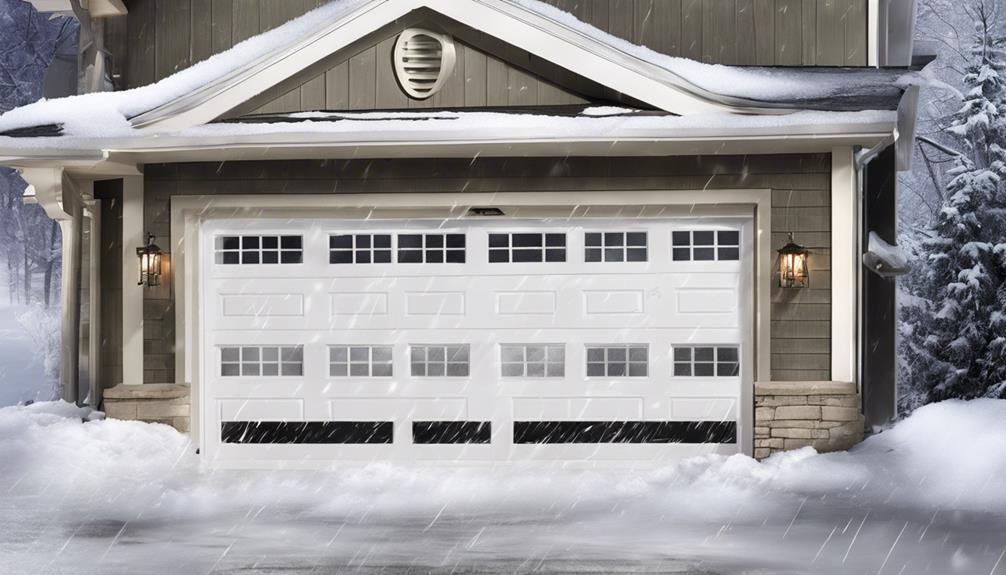
How does the durability of the Glink Garage Door Opener compare to other models on the market? When it comes to lasting strength and reliability, the Glink Garage Door Opener stands out from the competition. Here's why:
- Durable Materials: Crafted from high-grade steel and reinforced components, the Glink Garage Door Opener is built to withstand the test of time, ensuring longevity and robust performance.
- Advanced Motor Technology: Equipped with cutting-edge motor technology, this opener delivers powerful and efficient operation, enhancing its durability and overall functionality.
- Residential Garage Door Operation: Designed specifically for residential use, the Glink Garage Door Opener is tailored to meet the demands of daily home access, supporting consistent and reliable performance.
- Minimal Maintenance Requirements: With a focus on user convenience, this opener requires minimal maintenance, allowing homeowners to enjoy hassle-free operation without frequent upkeep tasks.
Standout Technology in Glink Opener
The advanced Wi-Fi connectivity of the Glink Garage Door Opener sets it apart in the realm of smart home technology, offering users convenient remote access to their garage door from any location. This feature enables seamless control through the Glink mobile app, empowering users to monitor and manage their garage door with just a few taps on their smartphone. Moreover, the Glink Opener's compatibility with voice assistants such as Amazon Alexa and Google Assistant adds a layer of hands-free convenience, allowing users to operate their garage door effortlessly using voice commands.
The integration of smart technology in the Glink Garage Door Opener further enhances its standout features. Through real-time alerts and notifications, users are kept informed about the status of their garage door, enhancing both security and peace of mind. Additionally, the ability to schedule automatic opening and closing times streamlines daily routines, making the overall user experience more efficient and tailored to individual preferences. The Glink Opener truly represents a modern approach to garage door operation, combining innovation with practicality for a liberating user experience.
Frequently Asked Questions
How Can I Boost My Garage Door Opener Signal?
To boost our garage door opener signal, we can take several steps.
Reposition the antenna for better reception and remove any obstructions blocking the signal.
Upgrading to a dual-frequency remote control can enhance signal strength.
Installing a repeater or range extender can amplify the signal.
Checking for interference from nearby electronics is crucial to ensure a smooth signal transmission.
These steps can help improve the overall performance of our garage door opener system.
Which Is Better a Chain or Belt Garage Door Opener?
When comparing a chain and belt garage door opener, it's crucial to consider factors like noise level, cost, reliability, and durability based on personal needs.
Chain openers are cost-effective and robust, ideal for heavy doors or high-traffic areas.
On the other hand, belt openers offer quieter operation and require less maintenance.
Ultimately, the choice depends on individual preferences, budget constraints, and specific garage door requirements.
What Is the Best Residential Garage Door Opener?
When it comes to choosing the best residential garage door opener, safety features like automatic reversing and rolling code technology are crucial. Battery backups ensure operation during power outages, while security lights provide added safety. Consider different types such as chain-driven, belt-driven, screw-driven, direct drive, and jackshaft models.
LiftMaster series like 8365, Elite Series 8550 DC, and 8500 offer excellent features for residential use, catering to various needs.
How Much Horsepower Do I Need for a 2 Car Garage Door?
We've got the know-how on garage door openers! A 1/2 horsepower opener is typically enough for a standard 2 car garage door.
If you've got a heavier or insulated door, consider bumping up to a 3/4 or 1 horsepower for optimal performance. The right horsepower ensures smooth operation and longevity for your opener.
Consult a pro to determine the best fit for your specific garage door setup.
Conclusion
In conclusion, the Glink Garage Door Opener truly shines with its innovative features, user-friendly design, reliable performance, and durability.
It stands out in the market for its advanced safety technology and standout features like automatic reversing and rolling code encryption.
With the Glink Garage Door Opener, you can rest assured that your garage door will operate smoothly and securely.
It's like having a guardian angel watching over your home's entrance.
- About the Author
- Latest Posts
Introducing Ron, the home decor aficionado at ByRetreat, whose passion for creating beautiful and inviting spaces is at the heart of his work. With his deep knowledge of home decor and his innate sense of style, Ron brings a wealth of expertise and a keen eye for detail to the ByRetreat team.
Ron’s love for home decor goes beyond aesthetics; he understands that our surroundings play a significant role in our overall well-being and productivity. With this in mind, Ron is dedicated to transforming remote workspaces into havens of comfort, functionality, and beauty.
Garage Door Opener
Silencing Your Garage Door Opener Humming: A Step-by-Step Guide
Discover how to silence your garage door opener humming with expert tips and tricks, transforming your space into a noise-free haven.

We’ve got you covered with practical steps to tackle the noise when it comes to silencing your garage door opener humming.
From pinpointing the source of the hum to exploring maintenance techniques, our guide offers a comprehensive approach to quieting your garage door opener.
By implementing these methods, you can create a peaceful environment without the constant background hum.
So, are you ready to transform your garage into a serene space?
Key Takeaways
- Inspect transformer for issues in Legacy 850/Standard Drive 650 models.
- Tighten all hardware components to minimize vibrations and humming.
- Regularly lubricate moving parts to reduce friction and noise.
- Adjust opener settings for optimized force and smooth operation.
Identifying the Source of Humming
To pinpoint the source of the humming noise in your garage door opener, start by examining the transformer located in the motor head for any signs of malfunction. The transformer is crucial for converting incoming power to the appropriate voltage needed to operate the DC motors in garage door openers like the Legacy 850 or Standard Drive 650.
If you own one of these models and notice a persistent humming sound, the transformer may be the culprit. For Legacy 850 or Standard Drive 650 units with a date code before 15198, replacing the transformer (part #39342RS) is often the solution. These replacement transformers for Overhead Door model openers can be easily sourced from www.OverheadDoorPartsOnline.com.
If you encounter any challenges during the replacement process or need further assistance, don't hesitate to reach out to your local Overhead Door distributor at 1-800-929-3667 for expert technical support. Identifying and addressing issues with the transformer can help silence the humming and ensure smooth operation of your garage door opener.
Inspecting and Tightening Hardware

Inspecting and tightening the hardware components of your garage door opener is crucial to identifying and addressing potential sources of humming noise. Begin by checking for loose nuts, bolts, and screws on the opener. Using a wrench, tighten all hardware components securely to reduce vibrations and minimize humming. Ensure that the mounting brackets, chains, and railings are properly fastened to prevent unnecessary movement and humming. It's also essential to inspect the motor head and drive system for any loose parts that could be causing the humming sound.
Regularly tightening and securing the hardware of your garage door opener is key to maintaining a quiet and efficient operation. Loose components can lead to increased vibrations and noise levels. By keeping all nuts, bolts, screws, mounting brackets, chains, railings, and motor head properly tightened, you can significantly reduce the humming noise coming from your garage door opener. This simple maintenance task can make a big difference in the overall performance of your garage door system.
Lubricating Moving Parts
When lubricating the moving parts of your garage door opener to reduce humming noise, ensure thorough coverage using a garage door lubricant or silicone-based option. Regular maintenance of your garage door opener includes proper lubrication of its moving parts such as the chain, belt, or screw drive. This lubrication helps reduce noise by preventing excess friction between the components. To assist you in understanding which lubricant to use and where to apply it, refer to the table below:
| Moving Parts | Recommended Lubricant |
|---|---|
| Chain Drive | Garage Door Lubricant |
| Belt Drive | Silicone-Based Lubricant |
| Screw Drive | Garage Door Lubricant |
Adjusting Garage Door Opener Settings

Adjust garage door opener settings to minimize humming noise by accessing the control panel and fine-tuning force and travel limits. Here's how to do it:
- Access the Control Panel:
- Locate the control panel on your garage door opener, usually found near the motor unit.
- Open the panel cover to reveal the adjustment settings.
- Adjust Force Settings:
- Use a flathead screwdriver to adjust the force settings on the opener.
- Increase or decrease the force to find the optimal setting that reduces resistance and noise.
- Fine-Tune Travel Limits:
- Locate the travel limit adjustment screws on the control panel.
- Gradually adjust the travel limits for both opening and closing directions.
- Test the door after each adjustment to ensure it opens and closes smoothly without excessive noise.
Seeking Professional Help
For addressing unusual humming sounds in your garage door opener, it is advisable to seek professional assistance from a certified technician. When dealing with a persistent humming noise coming from your garage door opener, it is crucial to involve experts who can accurately diagnose and resolve the issue. Certified technicians have the knowledge and experience to identify the source of the unusual sound and provide appropriate solutions to eliminate it effectively.
To guide you in understanding the benefits of seeking professional help, refer to the table below:
| Benefits of Seeking Professional Help | |
|---|---|
| 1. Expert Diagnosis | Certified technicians can pinpoint the exact cause of the humming noise. |
| 2. Precise Resolution | Professionals offer targeted solutions to resolve the issue efficiently. |
| 3. Technical Support | Get access to specialized assistance for your garage door opener complications. |
| 4. Prevent Further Damage | Avoid potential harm by allowing trained professionals to handle the motor head. |
When faced with a garage door opener humming problem, don't hesitate to reach out to a certified technician for technical support and expert troubleshooting.
Frequently Asked Questions
How Do I Silence My Garage Door Opener?
To silence your garage door opener, locate the source of the noise, which may be the motor head. Check the transformer for any issues causing the humming sound.
If you have a Legacy 850 or similar model, consider replacing the transformer part. For specific parts and guidance, visit OverheadDoorPartsOnline.com or reach out to a local distributor for assistance.
This process will help eliminate the unwanted noise from your garage door opener.
Why Is My Garage Door Opener Making a Humming Noise?
We discovered why our garage door opener is humming. It seems the culprit might be a faulty transformer in the motor head.
This issue is common in garage door openers with DC motors like the Overhead Door Phantom (777CD) and Legacy 850 (2029). If you have a Legacy 850 with a date code before 15198, replacing the transformer (part #39342RS) could be the fix.
Look for replacement transformers at www.OverheadDoorPartsOnline.com or call 1-800-929-3667 for help.
How Do I Make My Garage Door Not Loud?
To make our garage door not loud, we can start by lubricating the moving parts to reduce noise from friction. Check for loose chains or belts that might be causing the loudness.
Upgrading to a belt-driven opener can also help for quieter operation. Inspect the motor head for loose components.
If the noise persists, it's best to seek help from a professional technician for an effective solution.
How Do I Stop My Electric Buzzing?
If you're looking to halt that electric buzzing, we've got you covered.
First, pinpoint the source of the sound, often linked to a malfunctioning transformer in the motor head. Models like the Overhead Door Phantom (777CD) and Legacy 850 (2029) with DC motors commonly face this issue.
For specific models like the Legacy 850 or Standard Drive 650 predating 15198, think about replacing the transformer (part #39342RS).
Need replacement transformers? Check out www.OverheadDoorPartsOnline.com.
Conclusion
In conclusion, by following the steps outlined in this guide, we can effectively address the issue of garage door opener humming and ensure a more peaceful and efficient operation.
Remember, with regular maintenance and proper care, we can achieve a quieter and smoother functioning garage door opener.
Don't hesitate to seek professional assistance if needed, as it can further enhance the performance of your garage door system.
- About the Author
- Latest Posts
Introducing Ron, the home decor aficionado at ByRetreat, whose passion for creating beautiful and inviting spaces is at the heart of his work. With his deep knowledge of home decor and his innate sense of style, Ron brings a wealth of expertise and a keen eye for detail to the ByRetreat team.
Ron’s love for home decor goes beyond aesthetics; he understands that our surroundings play a significant role in our overall well-being and productivity. With this in mind, Ron is dedicated to transforming remote workspaces into havens of comfort, functionality, and beauty.
-

 Decor1 week ago
Decor1 week agoMaximalist Decor Explained: Embrace More Style
-

 Vetted2 weeks ago
Vetted2 weeks ago15 Best Foot Massagers for Neuropathy to Soothe Your Feet and Relieve Discomfort
-

 Vetted3 weeks ago
Vetted3 weeks ago15 Best Sports Laundry Detergents for Keeping Your Activewear Fresh and Clean
-

 Vetted3 weeks ago
Vetted3 weeks ago15 Best Tall Toilets for Seniors That Combine Comfort and Safety
-

 Vetted4 weeks ago
Vetted4 weeks ago15 Best Dish Scrubbers to Keep Your Kitchen Sparkling Clean
-

 Vetted2 days ago
Vetted2 days ago15 Best Cleaners for Fiberglass Showers to Keep Your Bathroom Sparkling Clean
-

 Decor4 weeks ago
Decor4 weeks agoWhat Is Eclectic Home Decor
-

 Vetted1 week ago
Vetted1 week ago15 Best Organic Pest Control Solutions for a Naturally Pest-Free Home

























